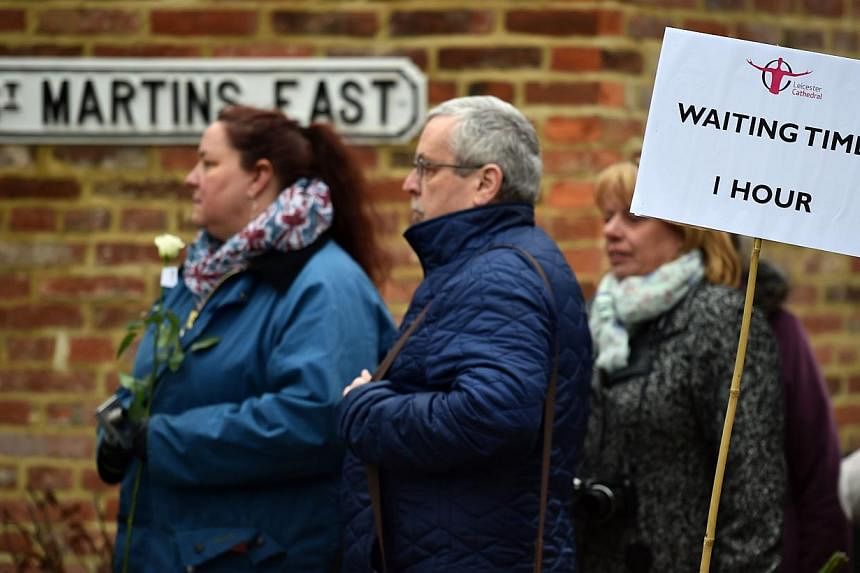LEICESTER (AFP) - Thousands queued up on Monday to pay their respects to King Richard III of England, whose remains were found in a car park over 500 years after his death and will be reburied this week.
Vilified by William Shakespeare and generations of Britons since being killed at the Battle of Bosworth in 1485, Richard's reputation is now being rehabilitated, with queues of up to four hours to see his coffin at Leicester Cathedral in central England.
That came after some 35,000 people lined the streets to view his funeral cortege Sunday, ahead of Thursday's final burial at the cathedral.
"People are giving him a wonderful, warm reception, I think they've learned more about who he was as opposed to the parody," Wendy Duldig, a distant relative of Richard III, said. "They're giving him a pretty good send-off, and I think he deserves that."
Visitors clutched white roses, the symbol of Richard's House of York, as they waited outside in chilly temperatures in a queue stretching far beyond the cathedral grounds.
Candles lit the dim cathedral interior and the coffin was draped in a dark shroud and topped with a gold-plated funeral crown set with enamelled white roses and gemstones.
It was flanked by armed forces veterans in full regalia as visitors filed past.
"It's the whole ambiguity about who he was, and what he stood for ... whether Shakespeare portrayed him correctly," said Joe Nugent, a teacher queuing to see the coffin. "We'll never know who the real man was but it's such an enigma and we're just pleased to be here."
Richard's remains were sealed in a lead box, and his bones packed in with woollen fleece, wadding and unbleached linen. Small bones were placed in linen bags, and a rosary placed inside.
The box fits inside a 1.8-metre-long oak coffin, made by Canadian carpenter Michael Ibsen, who is Richard's nephew 16 times removed and his closest living relative.
A requiem mass - a Catholic prayer ceremony for the deceased - was to be celebrated in the city later on Monday.
Richard, the last monarch of the Plantagenet dynasty, ruled England from 1483 until he was killed near Leicester by soldiers loyal to Henry Tudor, later Henry VII.
The slain 32-year-old was buried without fanfare at the city's Greyfriars monastery, which was demolished in the 1530s. Richard's remains were then thought to have been lost.
But they were unearthed them in 2012 and identified by matching Ibsen's DNA to that of the skeleton found under the municipal car park.
Another clue was the skeleton's distinctive curved spine which matched descriptions of the king at the time, and radiocarbon analysis dating the skeleton to between 1455 and 1540.
The discovery of his skeleton encouraged scholars to re-examine Richard's record of social reform, rather than relying on Shakespeare's Tudor-era portrayal of him as a murderous tyrant.
Historians credit Richard for developing the presumption of innocence in the legal system and the practice of granting bail.
However, Shakespeare also accused him of killing his nephews to claim the throne.
"Richard was not a man of peace. The times in which he lived and the role into which he was born did not permit that," Cardinal Vincent Nichols is expected to say in a homily during Monday's mass. "But now we pray for his eternal peace."

